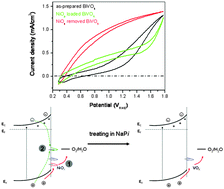Improving BiVO4 photoanodes for solar water splitting through surface passivation†
Abstract
BiVO4 has shown great potential as a semiconductor photoanode for solar water splitting. Significant improvements made during recent years allowed researchers to obtain a photocurrent density of up to 4.0 mA cm−2 (AM1.5 sunlight illumination, 1.23 VRHE bias). For further improvements of the BiVO4 photoelectrodes, a deep understanding of the processes occurring at the BiVO4–H2O interface is crucial. Employing an electrochemical loading and removal process of NiOx, we show here that carrier recombination at this interface strongly affects the photocurrents. The removal of NiOx species by electrochemical treatment in a phosphate electrolyte leads to significantly increased photocurrents for BiVO4 photoelectrodes. At a bias of 1.23 VRHE, the Incident Photon-to-Current Efficiency (IPCE) at 450 nm reaches 43% for the passivated BiVO4 electrode under back side illumination. A model incorporating heterogeneity of NiOx centers on the BiVO4 surface (OER catalytic centers, recombination centers, and passivation centers) is proposed to explain this improved performance.

- This article is part of the themed collection: Photosynthesis: From Natural to Artificial

 Please wait while we load your content...
Please wait while we load your content...